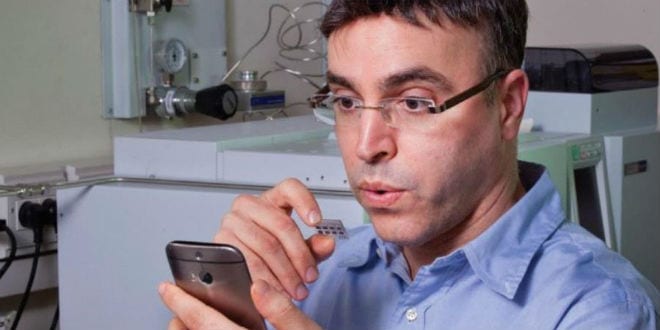Prof. Hossam Haick, a Christian Arab biochemical engineer born in Nazareth who lives in Haifa with his wife and family, has an impressive collection of inventions in his lab and several patents in his pocket. Coming from a family of academics that includes a doctor, an electronics engineer and a mathematics teacher, he was interested in science even as a young boy.
When he was only 33 years old, he was included as one of the world’s 35 “most-promising young scientists” in the Massachusetts Institute of Technology’s “TR35” list in its Technology Review magazine.
“I never wanted to be a physician,” he recalled. “I regard the practice of medicine as static. I prefer research, as it produces new technologies to treat patients.” And that is exactly what he has done.
Haick is a member of the Wolfson Faculty of Chemical Engineering at the Technion-Israel Institute of Technology and of the Russell Berrie Nanotechnology Institute in Haifa. He also heads the international SniffPhone consortium that integrates a breath analysis system into smartphones so that the data can be uploaded to a “cloud” in cyberspace for analysis by qualified medical personnel.
He took a close look at a 2,400-year-old medical hypothesis – that various diseases carry “chemical seals” identifiable in breath samples –and two years ago, confirmed it in an international study published in the journal ACS Nano. He thought that exhaled breath would be an excellent raw material for diagnosis, as it doesn’t require any invasive or unpleasant tests and poses no danger.
Haick used special sensors combined in his “Nano-Electric Nose” to study 1,404 patients, reaching a diagnostic accuracy rate of 86 percent of 17 chronic diseases that have no connection to each other. Those included cancer of the colon, lung, prostate, head and neck, ovaries, stomach and bladder; Parkinson’s disease; Crohn’s disease; ulcerative colitis; irritable bowel syndrome; multiple sclerosis; pulmonary hypertension; preeclampsia and chronic kidney disease.
“Each of the sensors responds to a wide range of breath components,” he explained. “And the integration of information provides detailed data on the signature unique disease characteristics. Some of the sensors are made of layers of nanometric gold particles, while others have a network of nanometric carbon tubes coated with an organic layer for sensing and identification.”
“Our system has made the discovery and classification of various diseases with exactitude averaging 86 percent. So this is a new direction and ensures the diagnosis and classification of diseases at low cost, low power consumption, miniaturization, comfort and the possibility to repeat the test easily.”
In addition to breath samples, they took conventionally used chemical samples and used mass spectrometry to assess the exact amounts of chemical compounds in each. Chemical components were found in each of the 17 diseases. The Technion scientist said that each disease is characterized by a unique “fingerprint” that differentiates it from other diseases.
But Haick has gone even farther by developing technology that seems taken from science fiction novels. Imagine that you are wearing a shirt, a watch, jewelry, shoes or glasses that continuously monitor your body functions and suddenly tell you and your doctor that some of your physiological markers have identified diseases in early stages of development.
Haick and his Chinese postdoctoral researcher Dr. Weiwei Wu developed the model for the innovative system that allows users to continue their daily routine without interruption. The system, whose details were just published in the journal Advanced Materials, is operated using energy drawn from its wearer – and can even repair itself in the event of a rupture or scratch. The device is also expected to provide extensive and detailed information for use in epidemiological studies.
Wearable devices for medical monitoring are gaining momentum as being a convenient and inexpensive platform for continuous collection of medical information without the need for invasive procedures. They also make possible early detection and treatment of disease, before it presents symptoms. The use of wearable devices is expected to encourage people to be more involved in their own health and make it possible for them to undergo fewer medical tests.
Although the various components of the system already exist, no platform has been developed until now that combines them all, giving it unprecedented monitoring capability.
A healthy person’s heart beats 60 to 100 times and his lungs breathe about seven or eight times per minute. If one can detect dramatic changes in the various markers in real time, the individual can be sent for a more comprehensive diagnosis and prevent complications.
Since the technology produces energy and can repair itself, the experimental device has a long lifespan and doesn’t have to be turned off electrical charging or repair. Its continuous monitoring of physiological markers will be beneficial not only to the individual user, but also for the long-term collection of extensive information that may be used for epidemiological studies.



